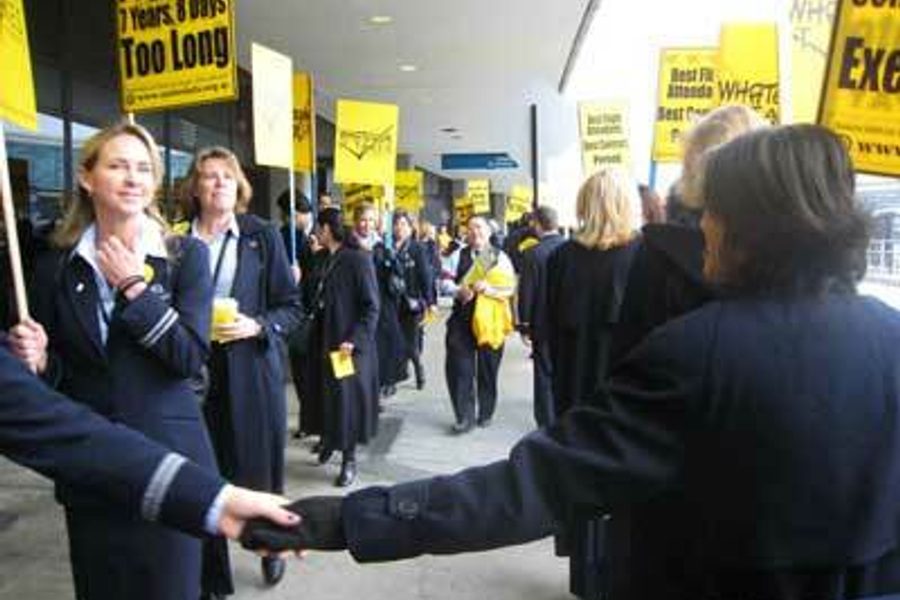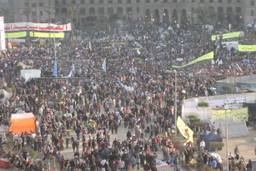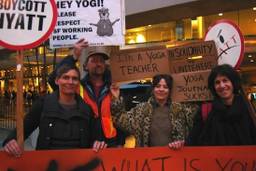
Today, these same workers stand as the lowest paid among all the major airlines, and they’re hardly getting any notice from management. Contract negotiations have stalled.
“We are working at 1994-wage levels after suffering wage cuts, staff reductions and rising healthcare costs,” Chris Black told several hundred flight attendants and other union supporters picketing on January 7 at United departure gates at San Francisco International Airport (SFO).
Black is SFO Council 11 President, Association of Flight Attendants (AFA-CWA), and it was her national AFL-CIO union that organized protests on the same day the association’s contract became amendable. A preliminary count by the AFA is that more than 1,800 employees participated at airports all over the world.
Contracts negotiated under the Railway Labor Act do not actually expire but rather become “amendable” with terms remaining “status quo” throughout negotiations overseen by the National Mediation Board. So, while the system does retain contract protections during negotiations, extremely long delays lasting several years have become commonplace.
In ordinary times, this means workers fall further and further behind rising living expenses as talks drag on. But the 2002-2006 bankruptcy of UAL forced even more extremely onerous concessions that substantially compounded the normal burden of delayed negotiations.
Union spokeswoman Sara Nelson said that “after the airline went bankrupt several years ago, the union accepted cuts of more than $3 billion in pay, working conditions and healthcare, along with the termination of workers’ pensions.
“We were promised the cuts would remain in place for a certain amount of time, but we continue to live under these concessions while executives have rewarded themselves with millions of dollars in bonuses,” Nelson said. As one example, UAL CEO Glenn Tilton’s bonus upon exiting bankruptcy was by itself sufficient to provide a 10% bonus for all 15,000 FA’s then on the payroll.
Race to the Bottom has Hit Rock Bottom
Attempting to achieve early settlements, each of the six unions currently in talks with UAL now have contract clauses providing for the commencement of negotiations several months before the amendable dates.
The AFA, for example, has been bargaining with UAL since April 2009, but to no avail. According to an AFA press statement, “members are angry that management has not discussed the improvements envisioned, seeming only interested in delaying….”
United, now dropped from first to the world’s third-largest airline, claims that a weakened economy, rising fuel costs and fluctuations in demand has enormously reduced profits. We heard this argument during bankruptcy when prominent union financial analyst Dan Akins estimates airline workers suffered reductions in wages and benefits totaling $11 billion.
This could actually be a low figure. A U.S. Government Accountability Office report estimated a “loss of $3.2 billion to [UAL] participants” alone just from the pension default.
In any case, everyone realizes the airline industry has always been characterized by intense competition, high fixed costs such as fuel, cyclical demand and vulnerability to intermittent economic lows. We also know from experience that whether in good times or in bad times, carriers have continuously sought concessions.
But with the enormously rising fuel costs since the Gulf War, United embarked on an even more dramatic and sustained burn and slash program of service, route and fleet reductions combined with unprecedented employee layoffs.
For example, the company reports that its workforce fell from 100,000 in December 2000 to 46,000 in December 2009 with FA numbers at 23,000 and 13,000 in that same period.
However, cutting back is an extremely controversial and unproven method of returning airlines to profitability.
Union leaders explain that reducing passenger capacity is not the answer. It is passengers that pay the bills and it has been shown historically that eliminating routes and laying off employees in fact lowers passenger-generated earnings more rapidly than reducing stable fixed costs. Reducing the operation is a discredited shortcut that fails to increase revenue, and therein lies the problem.
“Cutting its fleet of airplanes does not address the larger cost problems that continue to beleaguer this airline,” said then-UAL Air Line Pilots Association (ALPA) chairman Captain Steve Wallach in 2007. “Instead of doling out hundreds of millions of dollars to shareholders and pocketing millions of dollars in bonuses and salary increases, perhaps management should reinvest that money into our operation.”
His comments are still relevant today, and are echoed by current UAL ALPA chair Capt. Wendy Morse, who commented on the day of the AFA picketing that “United’s tactics to shrink to profitability has proved disastrous.”
Simply put, when airlines cut back, earnings generally fall more rapidly than costs.
With United management flying in the wrong direction, it is likely to be a tough round of negotiations for flight attendants. But there is some relief in sight. Airlines have made millions from their numerous increased fees. Fuel costs have also stabilized at around $80 a barrel from the high of well over $100. Even Wall St. analysts are cautiously optimistic.
“To sum up,” writes airline analyst Michael Derchin in the November 30, 2009 Yahoo Finance report, “we are looking for 2010 to be a modestly profitable year for the industry.”
In fact, there are already signs of deep-pocket business travelers returning to the soft, cushy, leather recliners in the front. These trends should provide some bargaining leverage for FA’s and other UAL employees who want to recover from their losses of recent years. But, of course, it is the collective solidarity of all the six unions currently bargaining that will be the most important factor influencing management.
The AFA set a good example by beginning to mobilize members and to reach out to other unions. This is a winning combination. As one Machinist union Local President commented to me wishfully, “we may be negotiating separately, but we should be fighting together.”
Carl Finamore was a UAL baggage handler at SFO and former President (ret), Air Transport Employees, Local Lodge 1781, AFL-CIO.







